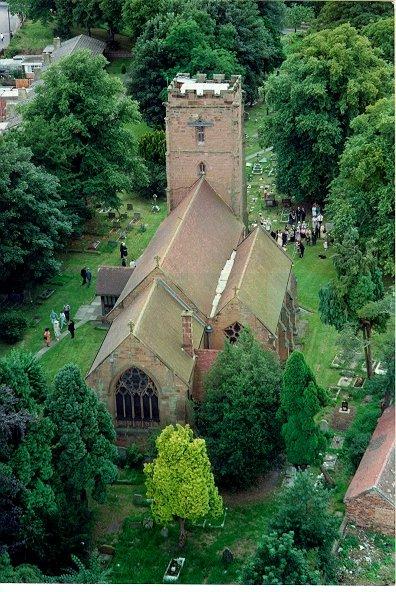A Visitor’s Guide to St Giles - The Churchyard
The visit to St Giles begins with the Lych Gate which was erected in1899 to mark the 50th year of Rev. B Jones-Bateman's Incumbency as Rector of Sheldon. He continued as Rector of the parish until 1910.
In an area of Church land, now a conservation area found next to the churchyard are two lines of trees - locally called 'The Limes'. It was originally planted by Rev. B Jones-Bateman to line his path to the church. The Churchyard has many specimen trees in it. One of the children's favourite is the Horse Chestnut - something to do with conkers! In medieval times churchyards provided wood for archers to make their long bows.
There are strange markings on the North side of the Tower. These marks were made by soldiers (Round heads) during the English Civil War (350 years ago). We are not really sure what sort of weapons made these marks; although we can assume that some were made in the attempt of the soldiers to sharpen their pikes. St Giles Church is made of sandstone. The walls are very thick and need to be, as sandstone is soft and crumbles over the years leaving us with a fine 'sandy beach'.
A careful inspection of the churchyard wall opposite the doors in the North Wall of the church reveals where there have been two gates. Behind this wall there was a small school for boys and girls. These gates correspond with the two doors in the north side of the church. Pupils would enter and exit church through these doors, boys through one and girls through the other. This was the second site of Sheldon School. The first site was where the current vestry is.
The school finally moved to the building in the car park. It was originally a barn- a maltings.
Look for a building built on the churchyard wall. We call it a Bier House (not to be confused with Beer!). It was originally sited on the other side of Church Road and was a stable. If you look carefully you will see the remains of a Chimney for a furnace. This would have been used to make horseshoes. Inside the Bier House is a Victorian Bier Cart used for carrying coffins.
The door next to the Lepers Squint (possibly the oldest part of the Church building) is a door which was used by the Rector when he lived in the Rectory farm.
The oldest part of St Giles Church is not the building but a grave. This can be found next to the porch. It could be the grave (coffin lid) of one of the priests who ministered in the original church. This Church made of mud and straw probably burnt down.
Entry to the church is via the porch on the south side of the building. The porch dates back to the mid-sixteenth century and would have offered limited protection for those working in the churchyard or for pall bearers after their exhausting duties of transporting coffins to the church. Now continue your tour by going inside the church.
